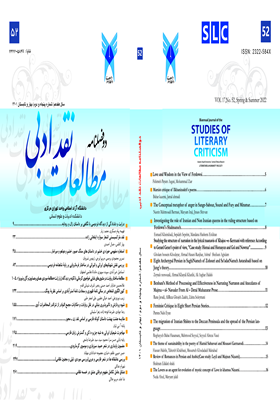Benbani’s Method of Processing and Effectiveness in Narrating Narraton and Anecdates of Majma – ol- Navader From Al – Deral Muhazarat Prose
Subject Areas : مطالعات نقد ادبی
rana javadi
1
,
Alireza ghojezade
2
*
,
Zahra Soleimani
3
![]()
1 - PhD student, Department of Persian Language and Literature, Faculty of Literature and Humanities, Varamin Pishva Branch, Islamic Azad University, Varamin, Tehran, Iran.
2 - Assistant Professor, Department of Persian Language and Literature, Faculty of Literature and Humanities, Varamin Pishva Branch, Islamic Azad University, Varamin, Tehran, Iran.
3 - Assistant Professor, Department of Persian Language and Literature, Faculty of Literature and Humanities, Varamin Pishva Branch, Islamic Azad University, Varamin, Tehran, Iran.
Keywords: Majma al, Nawadir.Benbani. Prose of al, Der al, Muhayharat. Abu Sa'id Abi. Fable,
Abstract :
Story writing has been one of the most widely used and popular ways of writing books over the centuries. Many writers have stepped in this valley and created valuable works, both in Persian and Arabic. The Majma 'al-Nawadir, written by Faiz al-Din Zeinolabedin Hesam Benbani (Zendeh 907 AH), is one of these valuable books which, according to the author himself, has been written on a new and new way in Persian by looking at the books of the predecessors in the end of Ijaz and Abbreviation. Among the most widely used sources of banbani are the prose of al-Der Waqiyat, written by Mansur b. Husayn Abi (cir; 345-422 AH), which is in Arabic and includes sayings, manners, rhetorical and delicate points. Considering the large number of common anecdotes as well as similar titles of these two works (Navader Metabain, Navader Tafilian, Navader Majanin, Teachers' Nevader, Women's Nevader, etc.) it seems. Banbani has paid attention to this book in the way of writing and dividing the Majma 'al-Nawadir, and the new way that Banbani claims to be, not merely an imitation of the prose he created according to this book. The manner in which persian works are not seen before banbani. In addition to translating anecdotes into Persian, Banbani has not limited himself to the blue method in al-Darr's prose in the use of anecdotes and titles, and has sometimes taken part in the structure of the anecdotes of this book or used the anecdotes under another title in the Majma 'al-Nawadir.
بنبانی، فیضالله بن زینالعابدین بن حسام، تاریخ صدر جهان، ش 462، کتابخانۀ خدابخش پتنه.
بنبانی، فیضالله بن زینالعابدین بن حسام، مجمعالنوادر، ش 4212، کاتب: عبدی بغدادی، تاریخ کتابت 12 ربیعالآخر 1025- نستعلیق عالی، کتابخانۀ نور عثمانیه استانبول.
حائری، عبدالحسین.(1357). فهرست کتابخانۀ مجلس شورای ملّی سابق، ج 21، تهران؛ کتابخانه مجلس شورای ملّی سابق.
حبیبی، عبدالحی، «طبقات محمود شاهی و مجمعالنوادر فیضالله بنیانی دو نسخۀ نادر پارسی،» یغما، ۱۳۳۲ش، س۶، شماره ۱.
حسینی، سیّد محمدتقی.(1394). فهرست دستنویس فارسی کتابخانه نور عثمانیه- استانبول، تهران؛ منشور سمیر.
ذکایى ساوى، مرتضى، ابوسعد آوى و نثر الدر، آینه پژوهش، مرداد و شهریور 1372ش، 20، ص 31 – 38.
زرکلی، خیرالدین.(1980 م). الاعلام، بیروت: دار العلم للملایین.
کحالة الدمشق، عمر بن رضا بن محمد راغب بن عبد الغنی.(1376ش). معجم المؤلفین، الناشر: مکتبة المثنى- بیروت، دار إحیاء التراث العربی بیروت.
منزوی، احمد.(1374). فهرست نسخههای خطّی فارسی، ج 6، تهران: سازمان چاپ انتشارات وزارت فرهنگ و ارشاد اسلامی، 1374
میر جلالالدین حسینی ارمو.(1358). تعلیقات النقض، تهران انتشارات انجمن آثار ملی.
نوشاهی الف، سیّد عارف.(1362). فهرست نسخههای خطّی فارسی موزۀ ملی پاکستان- کراچی، مرکز تحقیقات فارسی ایران و پاکستان- اسلامآباد.
Blochet, E, catalogue des manuscrits persans, v.1, p.221.N.315.
Rieuch,Bankipore catalogue of the Persian manuscripts in the British Museum, London,1966.
_||_
